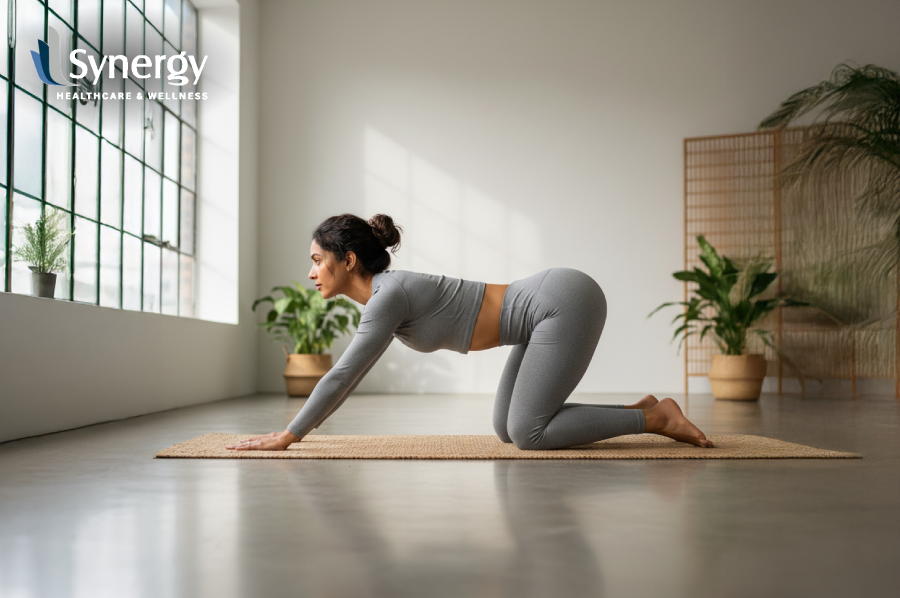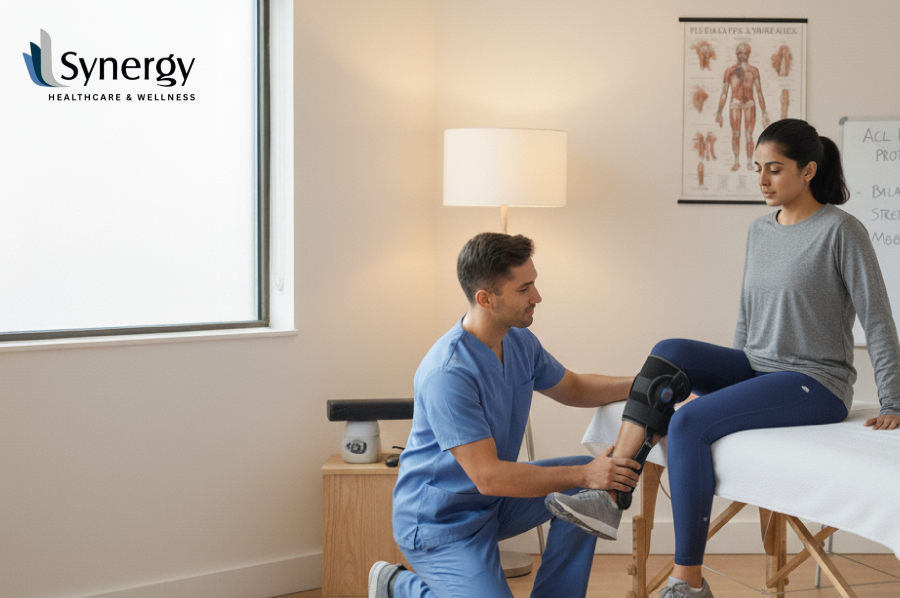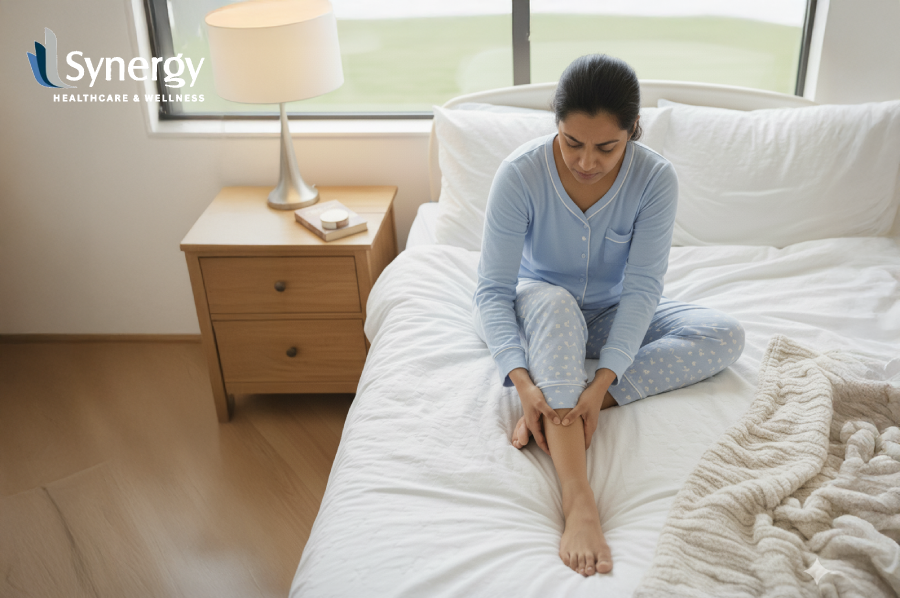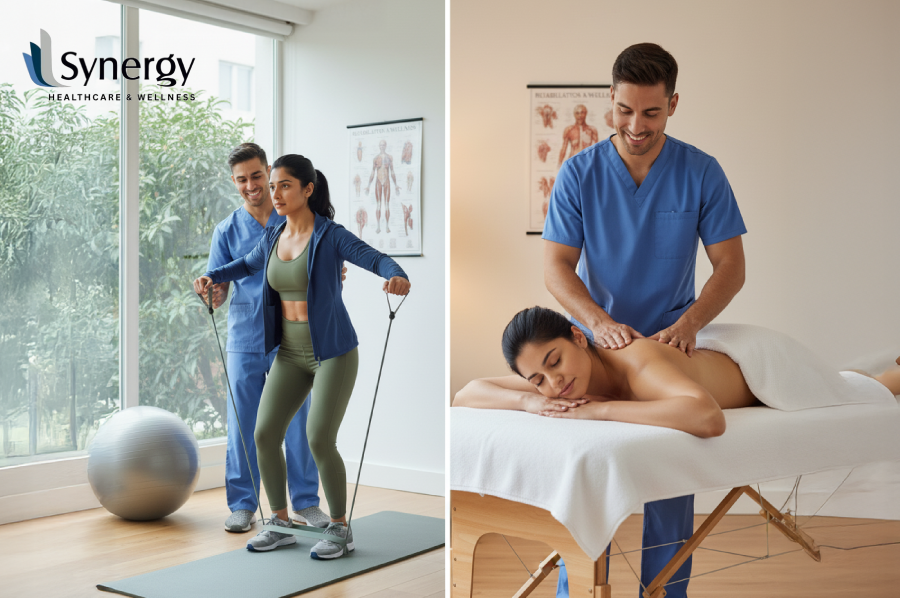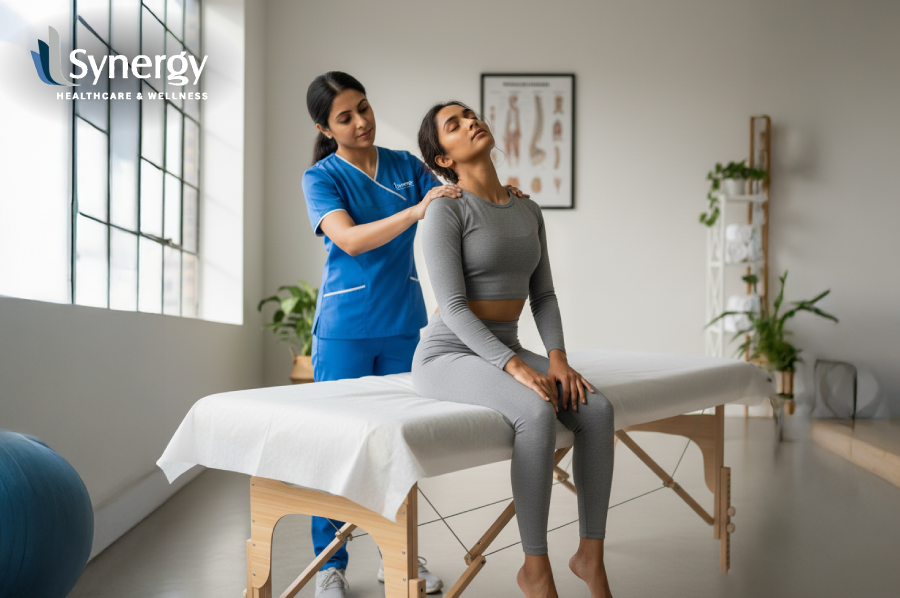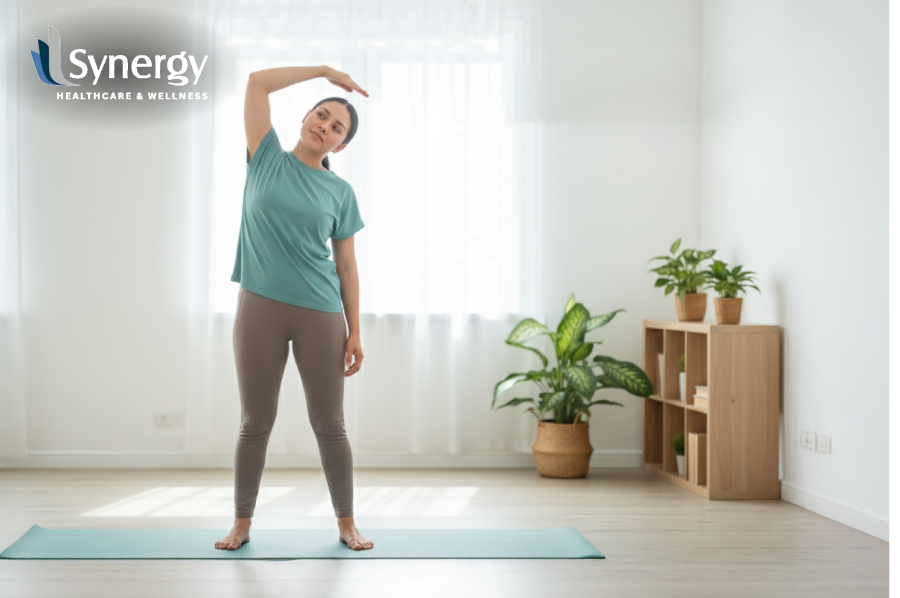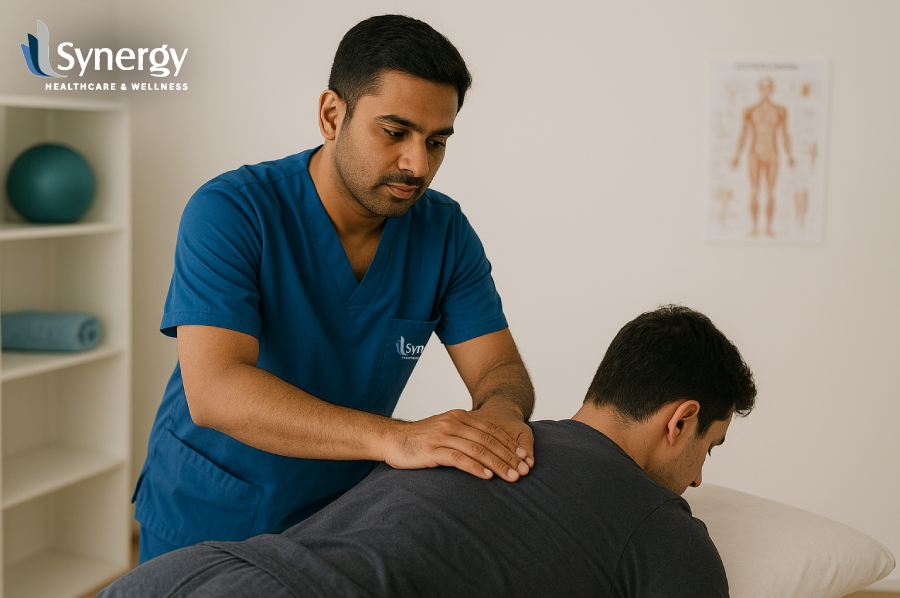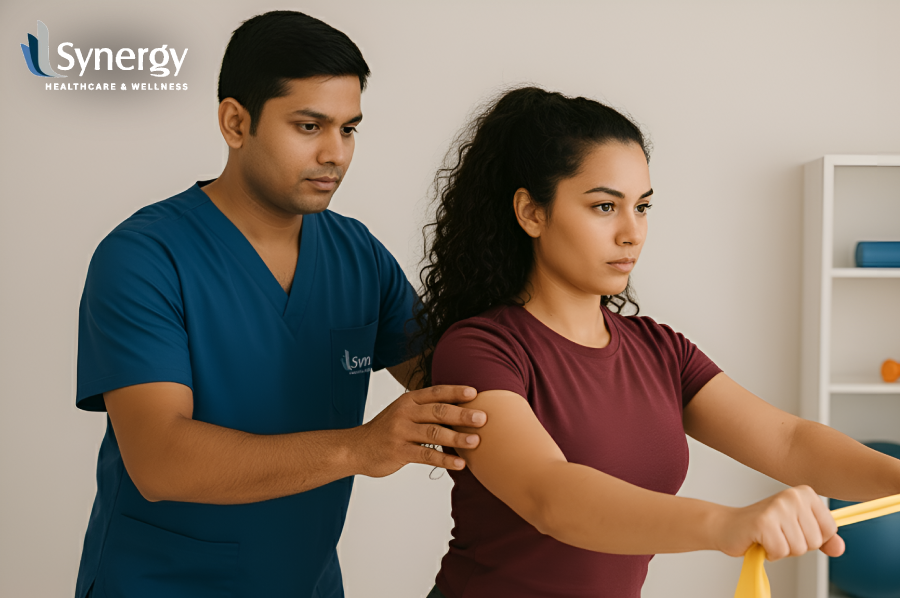This article explores five simple daily habits for back pain relief that support the spine, restore comfort, and help the body move more freely. Each habit is practical enough to apply in ordinary life, no complex routines or equipment required.
Daily Habits For Back Pain Relief
1. Keep the Body in Motion
The spine thrives on movement. Remaining still for too long – whether sitting at a desk, standing behind a counter, or scrolling through a phone – places unnecessary pressure on muscles and ligaments. Over time, this creates stiffness, reduced circulation, and aching along the back or neck.
A straightforward remedy is to move a little and often. Every twenty to thirty minutes, change position. Stand to stretch, walk across the room, roll the shoulders, or gently rotate the neck. Short, frequent breaks are more effective than occasional long ones. They refresh tired muscles and reduce tension before it becomes painful.
For those who sit most of the day, alternating between sitting and standing helps. A standing desk can be useful, though the aim is variety rather than perfection. Standing still for long periods can also cause strain, so balance is key.
Daily movement outside of work strengthens the effect. Activities such as brisk walking, swimming, or light cycling build endurance in the supporting muscles of the spine. The goal is not extreme fitness but regular, moderate activity that keeps joints supple and muscles active.
When pain is already present, gentle motion is often more helpful than rest. Prolonged inactivity weakens muscles and slows recovery. Move within comfort limits, but move nonetheless.
2. Build a Ten-Minute Strength and Flexibility Routine
Strong, flexible muscles protect the spine. They maintain alignment, absorb daily stresses, and reduce the risk of small strains becoming chronic problems. A simple ten-minute routine can provide noticeable improvement when practised consistently.
Begin with slow, controlled movements rather than sudden stretches. Focus on form and breathing. A few examples include:
- Cat–camel movement: Kneel on hands and knees, gently arch and round the back to mobilise the spine.
- Bridges: Lie on your back with your knees bent, lift your hips slightly, and hold for several seconds to strengthen your lower back and glutes.
- Pelvic tilts: Tilt the pelvis forward and backward while lying down to improve spinal control.
- Neck rotations: Slowly turn the head side to side and tilt the ear towards each shoulder, keeping movements light and smooth.
These can be completed at home, requiring only a mat or soft surface. Over time, add light resistance bands or small weights if strength improves.
Mindful forms of exercise, such as yoga or Pilates, can also help by combining stability, balance, and breathing control. The focus should remain on gentle, sustained effort rather than stretching to extremes. Pain should ease gradually; pushing through discomfort usually delays progress.
Regular practice teaches the body to move naturally again. It also restores confidence in motion, which often fades when people fear pain.
3. Set Up a Spine-Friendly Workspace
Modern life encourages hours of screen use, often in awkward positions. Over time, this shapes the posture into a forward head tilt and rounded shoulders—two of the main causes of neck and upper back pain.
A supportive workspace protects against these strains. When possible:
- Adjust the screen so its top edge is level with the eyes.
- Keep the keyboard and mouse at elbow height to prevent shrugging or hunching.
- Sit with the feet flat on the floor and the hips slightly higher than the knees.
- Bring devices up to eye level rather than lowering the head towards them.
Small changes, such as using a cushion for lumbar support or positioning frequently used items within reach, make a difference.
That said, no desk setup replaces the need for movement. Even with ideal ergonomics, sitting in one position too long will cause stiffness. Changing posture, standing for brief periods, and taking walking breaks remain essential.
For many people, tension in the neck and shoulders builds without notice. A helpful cue is to check posture each hour: draw the shoulders gently back, relax the jaw, and breathe deeply. These moments of awareness can reset muscle tone and reduce pressure throughout the day.
4. Sleep in Supportive Positions
Sleep restores both body and mind, but poor sleeping positions can undo much of the day’s care. The aim is to keep the spine in a neutral line during rest, neither overly curved nor twisted.
- Side sleepers often benefit from a medium-firm pillow that fills the space between the ear and shoulder. Placing a small cushion between the knees can also align the hips and reduce lower back strain.
- Back sleepers may prefer a flatter pillow to avoid forcing the neck forward. A soft pillow under the knees can ease pressure on the lumbar region.
Avoid stacking multiple pillows beneath the head or sleeping on overly high cushions, as these create sharp bends in the neck. Experiment with pillow height and firmness until the neck feels supported without tension.
Mattress support matters as well. A sagging mattress can contribute to morning stiffness. While comfort is personal, a balanced surface—neither too soft nor too hard—tends to keep the spine neutral.
Good sleep hygiene supports pain recovery. Keeping a regular bedtime, limiting screens before bed, and creating a calm environment allow the body to relax fully. A few minutes of gentle stretching or heat therapy before sleep can further ease tight muscles.
5. Balance Work, Rest, and Stress
Pain is influenced by both body and mind. Physical strain, emotional tension, and fatigue often feed one another, creating a loop of discomfort. Learning to balance these factors helps reduce both the intensity and frequency of pain.
- Use heat thoughtfully. Gentle warmth from a hot water bottle or warm shower relaxes tense muscles and improves circulation. Apply heat for fifteen to twenty minutes at a time, then move lightly to maintain the benefit.
- Pace physical tasks. Break larger chores into smaller steps with short pauses in between. Whether cleaning, gardening, or lifting, avoid long bouts of repetitive motion. Short rests prevent muscles from tightening and help energy last through the day.
- Manage stress actively. Emotional strain can heighten pain sensitivity by tensing the neck, shoulders, and lower back. Simple breathing exercises, brief mindfulness breaks, or quiet walks can lower this response.
- Keep realistic goals. Expecting immediate relief can lead to frustration and tension. Spinal comfort builds gradually as habits change. A consistent, steady routine always outperforms short bursts of enthusiasm.
- Stay connected. Talking through physical discomfort or work-related stress with supportive people can ease its emotional impact. Pain often feels less overwhelming when shared and understood.
Everyday Tips for Prevention
- Stay hydrated. Muscles and spinal discs rely on adequate fluid levels to stay supple.
- Lift mindfully. Keep objects close to the body, bend at the knees and hips, and avoid twisting suddenly.
- Watch the shoulders. They often creep upward during concentration. Drop them back and down to relieve the neck.
- Keep devices in line with sight. Whether reading or texting, raising the screen prevents the chin from jutting forward.
- Take gentle walks. A few minutes outdoors relieves stiffness, supports circulation, and refreshes concentration.
When to Seek Professional Help
While most back and neck discomfort improves with self-care, some signs require medical assessment. Seek professional advice if pain is severe, persistent, or linked with numbness, weakness, or changes in bladder or bowel control. Sudden, sharp pain after injury also warrants attention.
For long-standing discomfort that does not respond to movement or rest, a personalised programme from a healthcare professional can identify underlying causes and guide safe recovery.
Your Journey to Pain-Free Living Begins Here
At Synergy Physiotherapy, we believe in restoring movement through understanding rather than routine. Our approach combines clinical expertise with attentive care, focusing on the cause of pain rather than its surface symptoms. Each treatment plan is designed to suit the individual—balancing hands-on therapy, corrective exercise, and education.
Our team works to help patients rebuild strength, mobility, and confidence in their own bodies. From sports injuries to chronic conditions, we guide recovery with steady, evidence-based progress. At the heart of our work is a simple aim: to help every person move freely, live comfortably, and return to what they love.
Putting It All Together
Healthy backs and necks depend less on single exercises and more on everyday consistency. Movement, posture, sleep, and stress management form a connected system; each habit supports the others.
When movement becomes natural, rest becomes restorative, and daily routines stay balanced, the body begins to heal itself. The result is not simply the absence of pain but the return of ease, energy, and confidence in motion.
These five habits —regular movement, daily strength work, a supportive workspace, restorative sleep, and balanced stress—create a solid foundation for comfort. Adopt them patiently, adjust them to fit your routine, and allow time for improvement.
In most cases, the body responds well to care that is steady, simple, and respectful of its limits. The reward is lasting relief and a greater sense of physical freedom throughout daily life.
FAQs
1. What are the main causes of back and neck pain in daily life?
Most back and neck pain results from poor posture, long hours of sitting, weak supporting muscles, and repetitive strain. Everyday activities—like using mobile devices, working at a desk, or sleeping in awkward positions—can build tension over time.
2. Can daily habits really reduce chronic back and neck pain?
Yes. Consistent, small changes such as improving posture, moving regularly, and building core strength can reduce chronic pain. These habits support spinal alignment and prevent muscle stiffness.
3. What are the best exercises to relieve neck and back pain at home?
Gentle stretches like cat–camel movements, bridges, pelvic tilts, and neck rotations can ease stiffness and strengthen support muscles. Always move slowly and avoid forcing any position that causes pain.
4. How can I improve my posture while working at a desk?
Adjust your screen so the top edge is at eye level, keep your shoulders relaxed, and ensure your chair supports your lower back. Take short standing or stretching breaks every 30 minutes.
5. Which sleeping position is best for preventing neck and back pain?
A side or back sleeping position usually supports the spine best. Use a medium-firm pillow to keep your head level with your spine and a supportive mattress that prevents sagging.

